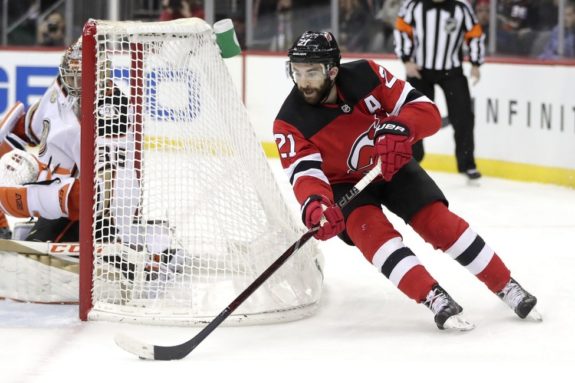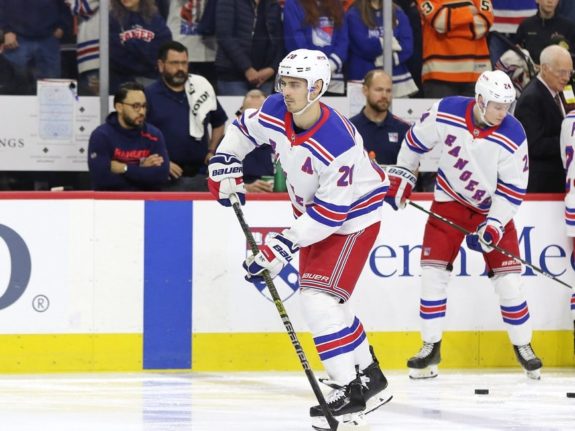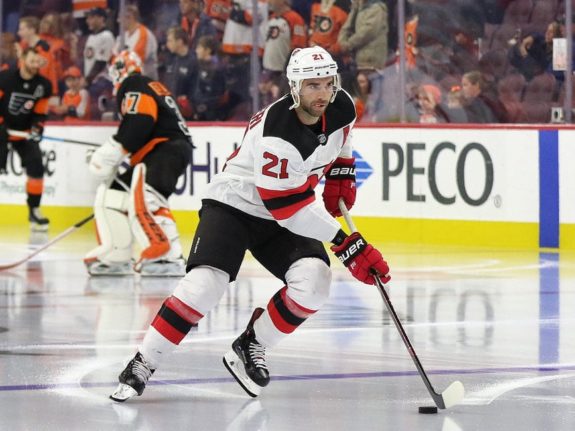One of the first moves of the New Jersey Devils’ rebuild in 2015 was acquiring right-winger Kyle Palmieri from the Anaheim Ducks. The team has had limited success since the trade, except for a playoff appearance in 2017-18. But that doesn’t mean the move didn’t pay off. In fact, it’s been quite the opposite.
Palmieri scored 30 goals in 2015-16, his first season with the Devils, and has never finished with less than 24 since then. He’s averaged 29.8 goals per 82 games, as well as 56 points per 82 games, and has turned into one of the team’s best two-way forwards. He’s entering the final year of his contract, meaning general manager Tom Fitzgerald will have a tough decision on his hands. Palmieri is a core player on the current roster, but he’ll be 30 years old when a new deal kicks in. And that means Fitzgerald will have to be careful in striking a new pact.
Palmieri’s Consistency
The lack of high-end shooting talent has been a problem for the Devils since the departure of Ilya Kovalchuk in 2013. Palmieri had shown signs of being a shooting threat in his first two seasons with the Ducks. But the minutes weren’t there for him on a stacked Ducks’ team that still had Ryan Getzlaf and Corey Perry at the top of their games. That’s when then-GM Ray Shero swooped in and acquired Palmieri as the first major transaction of his Devils’ tenure.
Since then, Palmieri has been a model of consistency. He’s played on the Devils’ top line a majority of the five seasons he’s been in New Jersey. Even as the team struggled during the 2019-20 season, he finished with 25 goals in 65 games, a 31-goal pace over 82 games. He also averaged 1.80 points/60 minutes at five-on-five, which was the same as John Tavares and better than TJ Oshie and Johnny Gaudreau.

Over the last three seasons, Palmieri has averaged 1.63 points/60 at five-on-five, which is what you’d expect from a second-line winger. But he’s more than made up for it with his power-play production. His points/60 on the man advantage ranks 27th in the league (min. 500 minutes logged) and is ahead of Jack Eichel, Patrik Laine, and Mark Stone.
But for as much as he contributes offensively, Palmieri shines on defense too. His even-strength defensive goals above replacement (GAR) of 5.5 ranks third on the Devils since 2017-18. And of players on the current roster, it’d rank first. He has an overall GAR of 32.5, ranked 48th among NHL forwards since 2017-18, a credit to his two-way play and power play production.
Related: Devils & Jesper Bratt: What Does the Next Deal Look Like?
And of course, there’s his shooting ability. Palmieri has scored 76 goals over the last three seasons, on an individual expected goals (ixG) of 60.24. He’s not the shooter that Laine, Leon Draisaitl, or Alexander Ovechkin are. But he is one of the more underrated shooting talents in the league. That should factor into the Devils’ decision-making, though how much should they be willing to pay?
Comparable Contracts for Palmieri
There have been quite a few extensions in recent years for players of Palmieri’s ilk. And many of those players have been in the same age range. Let’s take a look at some who offer the best examples.
Jordan Eberle
The New York Islanders acquired Eberle in a trade with the Edmonton Oilers in 2017. He put up 25 goals and 59 points in his first season with the Islanders but took a step back in 2018-19 — he finished with 37 points in 78 games. His GAR fell from 13 to minus-0.2 between the two seasons, so the drop in play was significant. That likely helped the Islanders get him at a bit of a discount, as he re-signed with them for a total of $27.5 million over five years ($5.5 million cap hit).

Eberle finished with 16 goals and 40 points in 59 games this season, a 56-point pace over 82 games. That’s right about what he’s averaged for his career, so he managed to bounce back in a big way. He’s not the two-way winger Palmieri is, but he has produced offense at a higher rate. So his extension likely offers the floor of what Palmieri could get.
Cam Atkinson
Atkinson has been a staple of the Columbus Blue Jackets’ lineup for close to a decade. He signed a lucrative extension in Nov. 2017, worth a total of $41.125 million over seven years ($5.875 million cap hit). His production leading up to that extension wasn’t all too different from Palmieri’s, either.
Atkinson averaged 1.67 points/60 from 2014-17, the three seasons before he signed an extension. He also averaged 53 points per 82 games and had a 35-goal season in 2016-17. For comparison’s sake, Palmieri has averaged 1.63 points/60 and 57 points per 82 games the last three seasons.
But where Palmieri has a significant advantage is on defense. Atkinson’s value comes almost all on offense — he had an even-strength defensive GAR of minus-13.3 from 2014-17. You don’t need me to tell you that’s less than ideal. That should also give Palmieri a good case to earn more than Atkinson. Though, this is where the Devils need to start being mindful of the price.
Chris Kreider
Kreider, like Palmieri, was a first-round pick at the 2009 Draft. He’s played his whole career with the New York Rangers and has developed into one of the more underrated wingers in the NHL. There was plenty of buzz around him at this past season’s trade deadline, but the Rangers struck an 11th-hour deal with the pending UFA, giving him an extension that pays him a total of $45.5 million over the next seven seasons ($6.5 million cap hit).

Kreider’s production is almost identical to Palmieri’s — he’s averaged 55 points per 82 games over the last three seasons. His GAR of 32.4 over that period is 0.1 less than Palmieri’s and ranks 49th among NHL forwards. That said, he’s been a more efficient scorer at five-on-five than Palmieri — he’s averaged 2.06 points/60.
There’s no doubt the two forwards are remarkably similar. They’re the same age, and their numbers are mirror images of each other. Palmieri may be a better two-way player, but it’s nitpicking at this point. If there’s a perfect contract comparable for Palmieri, Kreider appears to be it.
Anders Lee
Lee’s new deal wasn’t technically an extension, because the Islanders didn’t come to terms with him until July 1, 2019. That meant he was a UFA when he signed, but it’s not like he switched teams. So it’s worth breaking down his deal, which pays him a total of $49 million over seven years ($7 million cap hit).
Despite scoring 40 goals during the 2017-18 season, Lee’s production hasn’t been all that much better than Palmieri’s over that period. He’s averaged 55 points per 82 games, as well as 1.81 points/60 at five-on-five. Those are about even with Palmieri though Lee’s GAR of 20.9 ranks 111th among NHL forwards. That said, his GAR puts him among Alexander Ovechkin and Evander Kane, so he’s still in good company.
Related: 6 Devils Who’ll Benefit From Lindy Ruff
There’s a bit of an argument that Lee’s new deal was a slight overpayment. He’s a good player and a consistent 20-30 goal scorer, but he’s not better than Palmieri or Kreider. However, he is the Islanders’ captain, and that’s worth something. It likely played a bit of role in helping him hit the $7 million mark. If Palmieri becomes the Devils’ next captain, it might help him get a bit more money too. But $7 million annually should be where the buck stops for Devils’ management, and even that may be too much.
The Price Needs to Be Right
It’d be hard to fault the Devils for extending Palmieri. He’s been their most consistent player for five seasons, and he’s not showing any signs of decline. That said, he’ll be 30 when an extension kicks in. He plays a physical style of hockey that could lend to him declining in his early 30s too.

But there are a couple of counter-arguments. Palmieri is the Devils’ best shooting talent, and that makes him a perfect complement to Jack Hughes or Nico Hischier. If the Devils think they can be contenders in the next two to three years, then take the gamble and hope they can get productive years from him in the front half of a six to seven-year deal. The second argument is Palmieri’s shooting talent will help him age better than other players do in their 30s. So he could still be a productive player in the back half of an extension.
Now, what could a new deal look like? Kreider offers the best comparable without a doubt. If the Devils sign Palmieri to a seven-year deal, he should get somewhere around $6.25 to $6.5 million annually. His current cap hit is $4.65 million, so an extension at that price won’t add much to the team’s salary cap, either.
The bottom line is the Devils need to be careful with any extension for Palmieri. They’ll have $26 million in cap space this offseason, and $45 million in 2021-22 based on current projections. That’s a lot of money to throw around, but cap space is a difficult asset to get back once you’ve used it up. It’s why the margin of error for re-signing him is thin. Anything worth more than Kreider’s deal, and they’d likely be better off trading Palmieri. But for the right price, he’s a player worth keeping around to help the team, as well as Hughes and Hischier, make notable progress.
* * *
Advanced stats from Natural Stat Trick, Evolving Hockey